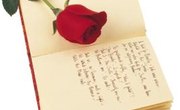Third-grade students appreciate the way poetry sounds. They like the rhythm and rhymes found in lines of poetry. Learning how to analyze the main ideas presented in the poem is the next step in understanding poetry.
Mood and Tone
As part of the process of analyzing poetry, the students understand the mood and tone of the poem. The mood is the feeling the poem gives the reader. Happy, sad, worried and grateful are all moods conveyed in poetry. The tone is how the author feels about the subject of the poem. If the author writes a happy poem about how great his dog is, the reader will also tend to like the author's dog. "I can hardly wait until my pizza is done, my wonderful pizza the size of the sun," writes Jack Prelutsky in "A Pizza the Size of the Sun." After reading this poem, the reader knows that Jack Prelutsky loves pizza.
Content
Analyzing the content of the poem involves finding the theme, or the main idea of the poem. The author wrote the poem to convey a message. Finding that message helps the reader understand the poem. Students should read the poem out loud several times, underlining lines they feel are important to understanding the poem. Help the third-grade students figure out who the narrator of the poem is. Knowing who is speaking gives more insight into the theme and the poem.
Form
A poem's form is how it looks on the page, and poetry takes many forms. Lines can be one word long, or a prescribed 14 syllables in length. Third-grade students will not study the pentameter, or line length, of poetry, but they will notice how the length of the line, the end punctuation and the stanzas all contribute to the meaning of the poem. One-word lines urge the reader to pause on that word. When the reader pauses, he thinks and reflects on that word longer. Stanzas are the paragraphs of poetry. Stanzas help the reader group thoughts in order to understand them.
Sound
The sound of the poem helps third-graders understand the poem. Rhyming words in poetry place emphasis on those words. The words are shouting, "Hey, take notice of me when they rhyme." The author wants you to hear those rhyming words. Third-grade students look for repeated words as they analyze the poem. If a word appears throughout the poem or is repeated successively, the author wants the reader to pay attention to that word. Words also add rhythm to the poem. "Hickory, dickory dock, the mouse ran up the clock," has a definite ticking rhythm that helps the reader understand the poem.
Related Articles
References
Writer Bio
Susan Rickey started writing in 1994 with a technology feature article for the "Pioneer Press." She was the writer of the Klamath Forest Alliance newsletter, an environmental organization. Rickey obtained her teaching credential from California State University and acquired her Bachelor of Science from the University of Arkansas.











